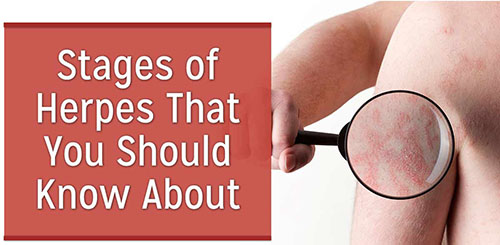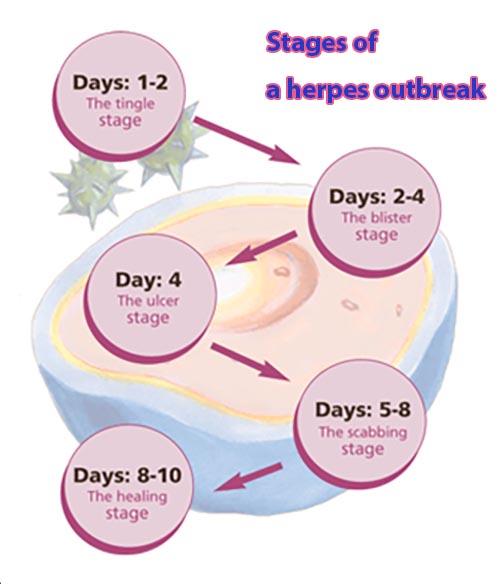Stages of Herpes Outbreak
An outbreak of herpes has a progression of blister development and healing.

- the prodrome stage
- development of blisters
- development of ulcers
- healing of ulcers
Do not deal with herpes alone! Connect other people with herpes.

PositiveSingles is one of the most popular dating websites for people suffering from herpes and other STD. It was initiated in 2001. With 1,510,800+ members you are sure to find lots of potentail people around you.
Join and meet nearby people with herpes, browse profiles and chat now!
Let's take a closer look at the herpes stages and what happens during each one.

Herpes Stages: 1) Prodrome
The prodrome is a phase of signs or symptoms that indicates the onset of an outbreak. People with genital herpes are considered to be highly contagious during this stage. During this stage of herpes outbreaks, the virus is traveling to the surface of the skin. This might cause redness, itchiness, tingling, pain, or burning in and around the affected area. Some patients may also feel pain while urinating, and female patients may notice some vaginal discharge. If the outbreak occurs inside the urethra or around the labia, painful urination can occur.
Prodrome — a period of symptoms that marks the onset of an outbreak, typically this stage lasts for several hours. During the prodrome of a herpes outbreak some might experience flu-like symptoms including fever, headache, or swollen glands. Pain can also occur in the legs, buttocks, or hips. These symptoms are generally worse if it the patient's first outbreak.
Even though sores and blisters have not developed during this part of the herpes stages, the skin is still highly contagious and remains contagious for the duration of the outbreak. (When is herpes not contagious).
Herpes Stages: 2) Skin Redness
Portions of the skin affected by the virus will turn red and become very sensitive. Plus, the areas where the outbreak is happening may also rise up, as the virus makes its way to the skin's surface. This will last for one to four days, with patients being very contagious at this stage as well.
Herpes Stages: 3) Blisters
Once the virus reaches the surface of the skin, blisters begin to form. Blisters from the herpes virus begin as small red bumps that become fluid filled (clear to whitish-yellow in color). Bumps and blisters can be sensitive or painful.
The skin around the blister appears red, and blisters commonly form in clusters. The appearance of blisters from herpes can be similar to pimples, ingrown hairs, jock itch, or razor burn. Because of these similarities, herpes is frequently mistaken for one of these other conditions.
Fever like symptoms can continue through this part of the herpes stages, but only if it is an outbreak associated with an initial infection.
These blisters contain virus-filled fluid, and grow to become very painful. This stage lasts for two to six days, and patients are advised to wear loose and comfortable clothing and avoid doing activities that may irritate the skin during this timeframe. The sores may stay open for one to four days.
Herpes Stages: 4) Ulcers
Eventually the blisters break and drain. When this occurs open sores called ulcers form at the site of the blister. Initially ulcers look like pink or red craters that ooze fluid or more rarely bleed. During this stage, the open sores are more uncomfortable or painful than preceding blisters.
Ulcers eventually accumulate dead cells into a soft material colored whitish-yellow. This material hardens and turns into a crust or scab. Crusts and scabs form by the area drying out, which doesn't happen in wet areas like inside the mouth or genitals.
Once all the fluid has drained, the lesions will become dry and a scab will emerge. Some blisters, however, do not turn into scabs, but just disappear slightly until they're no longer visible. Scabs stay on the skin for a couple of days. Patients are advised to refrain from touching or picking at the scabs to avoid scarring.
Herpes Stages: 5) Healing
Ulcers can take a long time to heal. During an initial herpes outbreak, healing can take 2 to 4 weeks. Healing during subsequent outbreaks is usually quicker.
As ulcers crust and scab, they begin to heal from the outside in. Itchiness is a common symptom during this stage. The scab or crust may crack, possibly causing some bleeding to occur. After the scab is gone, the area may remain red for a while. Scarring can occur if the scabs are picked at.
Cold sore stages images- Stages Of Cold Sores

- 1st Stage – Itching and irritating nerve tingling that begin 24 hours before the eruption of blisters.
- 2nd Stage – Appearance of fluid-filled blisters.
- 3rd Stage – The blisters burst and ooze, forming painful sores.
- 4th Stage – The sores dry up and start scabbing and may cause itching and cracking.
- 5th Stage – The scab finally falls off, and the sore begins healing.
What can trigger herpes outbreaks?
Do you know what triggers your herpes outbreaks? Several factors may trigger herpes outbreaks. Conitue to read What causes herpes to recur?
The #1 dating site to meet other people with herpes

PositiveSingles is one of the most popular dating websites for people suffering from herpes and other STD. It was initiated in 2001. With 1,510,800+ members you are sure to find lots of potentail people around you.
Know more facts about herpes outbreak:
First herpes outbreak | Recurrent herpes outbreaks | Stages of a herpes outbreak | How long does a herpes outbreak last | How often do herpes outbreaks occur? | What can trigger herpes outbreaks? | How to recognize a herpes outbreak? | How to prevent herpes outbreaks | Viral shedding | Herpes treatment | How to strengthen your immune system
